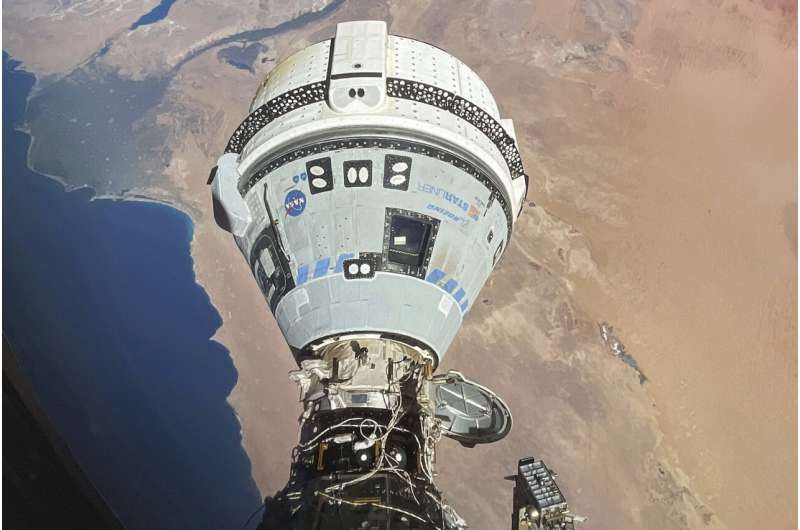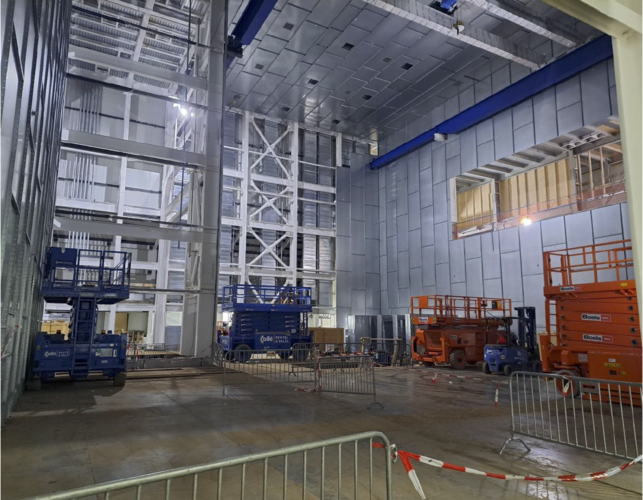NASA Halts VIPER Project to Refocus Lunar Exploration Efforts
Thursday, 18 July 2024 20:54 NASA has decided to discontinue the VIPER (Volatiles Investigating Polar Exploration Rover) project after a thorough internal review. The decision was made due to escalating costs, launch delays, and potential future financial risks.
Initially slated for a late 2023 launch, the VIPER project was postponed to late 2024 to allow for additional preflight testing of the Astrobotic lander. Howe
NASA has decided to discontinue the VIPER (Volatiles Investigating Polar Exploration Rover) project after a thorough internal review. The decision was made due to escalating costs, launch delays, and potential future financial risks.
Initially slated for a late 2023 launch, the VIPER project was postponed to late 2024 to allow for additional preflight testing of the Astrobotic lander. Howe Astronomers spot a "highly eccentric" planet on its way to becoming a hot Jupiter
Thursday, 18 July 2024 20:54 Hot Jupiters are some of the most extreme planets in the galaxy. These scorching worlds are as massive as Jupiter, and they swing wildly close to their star, whirling around in a few days compared to our own gas giant's leisurely 4,000-day orbit around the sun.
Scientists suspect, though, that hot Jupiters weren't always so hot and in fact may have formed as "cold Jupiters," in more frigid
Hot Jupiters are some of the most extreme planets in the galaxy. These scorching worlds are as massive as Jupiter, and they swing wildly close to their star, whirling around in a few days compared to our own gas giant's leisurely 4,000-day orbit around the sun.
Scientists suspect, though, that hot Jupiters weren't always so hot and in fact may have formed as "cold Jupiters," in more frigid Max Planck develops key components for Roman Space Telescope
Thursday, 18 July 2024 20:54 Engineers and scientists from the Max Planck Institute for Astronomy (MPIA), under the leadership of Oliver Krause, have successfully developed and delivered critical optical elements for the Coronagraph Instrument (CGI) of the Roman Space Telescope to the Jet Propulsion Laboratory (JPL) in the USA. The fully assembled CGI has now reached NASA's Goddard Space Flight Centre (GSFC), where it will
Engineers and scientists from the Max Planck Institute for Astronomy (MPIA), under the leadership of Oliver Krause, have successfully developed and delivered critical optical elements for the Coronagraph Instrument (CGI) of the Roman Space Telescope to the Jet Propulsion Laboratory (JPL) in the USA. The fully assembled CGI has now reached NASA's Goddard Space Flight Centre (GSFC), where it will University of Freiburg Launches Major Initiative in Earth and Planetary Geodynamics
Thursday, 18 July 2024 20:54 The University of Freiburg has announced the establishment of a new tenure track professorship in Earth and Planetary Geodynamics within the Faculty of Environment and Natural Resources. This development is supported by a 1.71 million euro grant from the Volkswagen Foundation. This tenure track professorship is part of a broader initiative to integrate Earth system sciences with planetary scienc
The University of Freiburg has announced the establishment of a new tenure track professorship in Earth and Planetary Geodynamics within the Faculty of Environment and Natural Resources. This development is supported by a 1.71 million euro grant from the Volkswagen Foundation. This tenure track professorship is part of a broader initiative to integrate Earth system sciences with planetary scienc Axelspace Unveils AxelLiner Laboratory for In-orbit Space Component Demonstrations
Thursday, 18 July 2024 20:54 Axelspace Corporation has introduced AxelLiner Laboratory (AL Lab), an expansion of its AxelLiner service initiated in 2022. AL Lab is designed for the in-orbit demonstration of space components, with sales launching soon.
A new memorandum was also signed between Axelspace and ASPINA Shinano Kenshi Co., Ltd., a partner since 2020 in developing a reaction wheel for microsatellites. The comp
Axelspace Corporation has introduced AxelLiner Laboratory (AL Lab), an expansion of its AxelLiner service initiated in 2022. AL Lab is designed for the in-orbit demonstration of space components, with sales launching soon.
A new memorandum was also signed between Axelspace and ASPINA Shinano Kenshi Co., Ltd., a partner since 2020 in developing a reaction wheel for microsatellites. The comp Blackline Unveils AlertLink for Enhanced Safety and Emergency Response
Thursday, 18 July 2024 20:54 Blackline Safety Corp. (TSX: BLN), a global leader in connected safety technology, has introduced the new AlertLink feature for its acclaimed EXO and G7 devices.
AlertLink provides proximity-based warnings to improve employee safety by offering advance alerts about potential dangers, facilitating quicker evacuations and incident responses. The feature was developed following feedback from
Blackline Safety Corp. (TSX: BLN), a global leader in connected safety technology, has introduced the new AlertLink feature for its acclaimed EXO and G7 devices.
AlertLink provides proximity-based warnings to improve employee safety by offering advance alerts about potential dangers, facilitating quicker evacuations and incident responses. The feature was developed following feedback from Soracom Launches Global Preview of Skylo Integration
Thursday, 18 July 2024 20:54 Soracom, Inc., a leader in advanced Internet of Things (IoT) connectivity, has announced the progression of its integration with Non-Terrestrial Network (NTN) service operator Skylo from Private Beta to a global initial rollout for select customers. During the keynote at Soracom Discovery 2024, Soracom CTO and co-founder Kenta Yasukawa and Skylo CEO and co-founder Parth Trivedi revealed that qua
Soracom, Inc., a leader in advanced Internet of Things (IoT) connectivity, has announced the progression of its integration with Non-Terrestrial Network (NTN) service operator Skylo from Private Beta to a global initial rollout for select customers. During the keynote at Soracom Discovery 2024, Soracom CTO and co-founder Kenta Yasukawa and Skylo CEO and co-founder Parth Trivedi revealed that qua Boeing is closer to understanding thruster failures on its first astronaut flight with latest test
Thursday, 18 July 2024 18:10
Boeing is closer to understanding what went wrong with its astronaut capsule in orbit, now that testing is complete on a spare thruster here on Earth.
The Starliner capsule has been docked at the International Space Station since June 6. It should have returned with its NASA test pilots by mid-June, but thruster failures and helium leaks prompted NASA and Boeing to extend its stay.
Officials said Thursday there's still no return date for astronauts Butch Wilmore and Suni Williams.
Preparing for Juice’s daring double flyby
Thursday, 18 July 2024 13:00
Next month, ESA’s Jupiter Icy Moons Explorer (Juice) will carry out the first combined lunar-Earth flyby. Preparations are under way at ESA mission control for this highly precise manoeuvre, which will harness the gravitational forces of the Moon and Earth in quick succession to line Juice up for the next stage of its journey to Jupiter.
Maxar Intelligence unveils first images from next-generation WorldView Legion satellites
Thursday, 18 July 2024 11:45
Amazon gears up for NASA satellite data relay demonstration
Thursday, 18 July 2024 11:18

Artemis II: no pressure
Thursday, 18 July 2024 11:00 Image:
Image:
The Orion vehicle that will bring astronauts around the Moon and back for the first time in over 50 years was recently tested in a refurbished altitude chamber used during the Apollo era.
Engineers tested Orion in a near-vacuum environment designed to simulate the space conditions the vehicle will travel through during its mission towards the Moon. Teams emptied the altitude chamber of air, a process taking up to a day, to create a very low-pressure environment over 2000 times lower and more vacuum-like than inside your vacuum cleaner. Orion remained in the altitude chamber’s low-pressure environment for around a
The next full moon is the buck or thunder moon
Thursday, 18 July 2024 09:47
The next full moon will be Sunday morning, July 21, 2024, appearing opposite the sun (in Earth-based longitude) at 6:17 AM EDT. For the International Date Line West and the American Samoa and Midway time zones this will be late Saturday night. For Line Islands Time this will be early Monday morning. The moon will appear full for about three days around this time, from Friday evening through Monday morning, making this a full moon weekend.
The Maine Farmers' Almanac began publishing "Indian" names for full moons in the 1930s and these names are now widely known and used. According to this almanac, as the full moon in June the Algonquin tribes of what is now the northeastern United States called this the Buck moon. Early summer is normally when the new antlers of buck deer push out of their foreheads in coatings of velvety fur. They also called this the Thunder moon because of early Summer's frequent thunderstorms.
Europeans called this the Hay moon for the haymaking of early summer, and sometimes the Mead moon (although this name was also used for the previous full moon).



 Image:
Heart of Hertz 2.0
Image:
Heart of Hertz 2.0